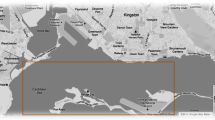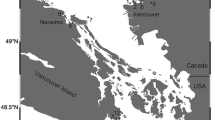Abstract
A field study was conducted to examine bioaccumulation of polychlorinated biphenyls (PCBs) for hatchery-raised and naturally reared (wild) ocean-type juvenile chinook salmon outmigrating through the Lower Duwamish Waterway (LDW), a contaminated urban estuary in Seattle, WA, USA. These results show differences in bioaccumulation of PCBs over time and space in this estuary, which may also occur for any contaminant that is distributed heterogeneously in this system. Highly mobile, outmigrating salmon accumulated ~3–5 times more PCBs on the east side of the LDW than fish on the west side, which is supported by an almost identical difference in mean sediment concentrations. The tPCB concentration data suggest that for most of the spring and early summer, juvenile chinook were likely segregated between the east and west side of the LDW, but may have crossed the channel later in the year as larger fish. Additionally, we used biota-sediment accumulation factors to assess the relative degree of bioaccumulation and explore these factors as potential metrics for predicting adverse sediment concentrations. These results highlight the importance of time and space in sampling design for a highly mobile species in a heterogeneous estuary.




Similar content being viewed by others
References
Brett JR (1995) Energetics. In: Groot C, Margolis L, Clarke WC (eds) Physiological ecology of pacific salmon. UBC Press, Vancouver, pp 3–68
Cordell J, Toft J, Cooksey M, Gray A (2006) Fish assemblages and patterns of chinook salmon abundance, diet, and growth at restored sites in the Duwamish river. Report to the technical and steering committee for WRIA 9, King Conservation District, Salmon recovery funding board. Available from http://your.kingcounty.gov/dnrp/library/2006/kcr1953.pdf
Giesy JP, Kannan K (1998) Dioxin-like and non-dioxin-like toxic effects of polychlorinated biphenyls (PCBs): implications for risk assessment. Crit Rev Toxicol 28:511–569
Gilbert RO (1987) Statistical methods for environmental pollution monitoring. Van Nostrand Reinhold Company, New York
Healey MC (1991) Life history of chinook salmon (Oncorhynchus tshawytscha). In: Groot C, Margolis L (eds) Pacific salmon life histories. UBC Press, Vancouver, pp 313–393
Industrial Economics (1997) Sample and analysis plan duwamish waterway sediment study. Available from the author (JP Meador) and the Damage Assessment Center, NOAA, 7600 Sand Point Way, Seattle
Industrial Economics (1998) Duwamish waterway sediment characterization study report. Available from the author (JP Meador) and the Damage Assessment Center, NOAA, 7600 Sand Point Way, Seattle
Krahn MM, Ylitalo GM, Buzitis J, Sloan CA, Boyd DT, Chan S-L (1994) Screening for planar chlorobiphenyl congeners in tissues of marine biota by high-performance liquid chromatography with photodiode array detection. Chemosphere 29:117–139
Lassiter RR, Hallam TG (1990) Survival of the fattest: implications for acute effects of lipophilic chemicals on aquatic populations. Environ Toxicol Chem 9:585–595
LDWG (2007) Lower Duwamish Waterway remedial investigation, draft remedial investigation report. Available via http://www.ldwg.org/rifs_docs.htm
Levings CD, McAllister CD, Chang BD (1986) Differential use of the Campbell River estuary, British Columbia, by wild and hatchery-reared juvenile Chinook salmon (Oncorhynchus tshawytscha). Can J Fish Aquat Sci 43:1386–1397
Meador JP (2006) Rationale and procedures for using the tissue-residue approach for toxicity assessment and determination of tissue, water, and sediment quality guidelines for aquatic organisms. Hum Ecol Risk Assess 12:1018–1073
Meador JP, Collier TK, Stein JE (2002) Use of tissue and sediment based threshold concentrations of polychlorinated biphenyls (PCBs) to protect juvenile salmonids listed under the US endangered species act. Aquat Conserv Mar Fresh Ecosyst 12:493–516
Meador JP, Buzitis J, Bravo C (2008) Using fluorescent aromatic compounds (FACs) in bile from juvenile salmonids to determine exposure to polycyclic aromatic hydrocarbons. Environ Toxicol Chem 27:845–853
Nelson TS, Ruggerone G, Kim H, Schaefer R, Boles M (2004) Juvenile Chinook migration, growth and habitat use in the lower Green River, Duwamish River and nearshore of Elliott Bay 2001–2003. Draft Report, King County Department of Natural Resources and Parks, Seattle
Ruggerone GT, Jeanes E (2004) Salmon utilization of restored off-channel habitats in the Duwamish estuary 2003. Prepared for environmental resource section, US Army Corps of Engineers, Seattle district by Natural Resources Consultants, Inc. and R2 Consultants, Inc., Seattle. Available from JP Meador
Ruggerone GT, Nelson TS, Hall J, Jeanes E (2006) Habitat utilization, migration timing, growth, and diet of juvenile Chinook salmon in the Duwamish River and estuary. Prepared by Natural Resources Consultants, Inc. for the King Conservation District and Salmon recovery funding board. ftp://dnr.metrokc.gov/dnr/library/2006/kcr1953.pdf
Sieler D, Volkhardt G, Kishimoto L, Topping P (2002) 2000 Green River juvenile salmonid production evaluation. Washington Department of Fish and Wildlife Report FPT 02-03. Available at http://wdfw.wa.gov/fish/wild_salmon_monitor/publications/2000greenriver.htm
Sloan CA, Brown DW, Ylitalo GM, et al (2006) Quality assurance plan for analyses of environmental samples for polycyclic aromatic compounds, persistent organic pollutants, fatty acids, stable isotope ratios, lipid classes, and metabolites of polycyclic aromatic compounds. Tech Memo NMFS-NWFSC-77, NOAA Fisheries, National Oceanic and Atmospheric Administration, Seattle
Steevens JA, Reiss MR, Pawlisz AV (2005) A methodology for deriving tissue residue benchmarks for aquatic biota: a case study for fish exposed to 2, 3, 7, 8-tetrachlorodibenzo-p-dioxin and equivalents. Integr Environ Assess Manag 1:142–151
Stow CA, Jackson LJ, Amrhein JF (1996) An examination of the PCB: lipid relationship among individual fish. Can J Fish Aquat Sci 54:1031–1038
Thorpe JE (1994) Salmonid fishes and the estuarine environment. Estuaries 17:76–93
van den Berg M, Birnbaum L, Bosveld A et al (1998) Toxic equivalency factors (TEFs) for PCBs, PCDDs, PCDFs for humans and wildlife. Environ Health Perspect 106:775–792
Varanasi U, Casillas E, Arkoosh MR, et al (1993) Contaminant exposure and associated biological effects in juvenile chinook salmon (Oncorhynchus tshawytscha) from urban and nonurban estuaries of Puget Sound. NOAA Technical Memorandum NMFS NWFSC-8. Available at http://www.nwfsc.noaa.gov/publications/displayinclude.cfm?incfile=technicalmemorandum1993.inc
Ylitalo GM, Buzitis J, Boyd DT, Herman DP, Tilbury KL, Krahn MM (2005a) Improvements to high-performance liquid chromatography/photodiode array detection (HPLC/PDA) method that measures dioxin-like polychlorinated biphenyls and other selected organochlorines in marine biota. In: Ostrander GK (ed) Techniques in aquatic toxicology, vol 2. CRC Press, Boca Raton, pp 449–464
Ylitalo GM, Yanagida GK, Hufnagle L, Krahn MM (2005b) Determination of lipid classes and lipid content in tissues of aquatic organisms using a thin layer chromatography/flame ionization detection (TLC/FID) microlipid method. In: Ostrander GK (ed) Techniques in aquatic toxicology, vol 2. CRC Press, Boca Raton, pp 227–237
Acknowledgments
We thank Sean Sol, Maryjean Willis, Mark Myers, O. Paul Olson, Gladys Yanagida, Dan Lomax, and Bernadita Anulacion for assistance with field collections, sample preparation, and analytical analyses. Jay Field and Lyndal Johnson provided several insightful comments on this manuscript.
Author information
Authors and Affiliations
Corresponding author
Additional information
An erratum to this article can be found at http://dx.doi.org/10.1007/s10646-011-0833-8
Rights and permissions
About this article
Cite this article
Meador, J.P., Ylitalo, G.M., Sommers, F.C. et al. Bioaccumulation of polychlorinated biphenyls in juvenile chinook salmon (Oncorhynchus tshawytscha) outmigrating through a contaminated urban estuary: dynamics and application. Ecotoxicology 19, 141–152 (2010). https://doi.org/10.1007/s10646-009-0399-x
Received:
Accepted:
Published:
Issue Date:
DOI: https://doi.org/10.1007/s10646-009-0399-x




